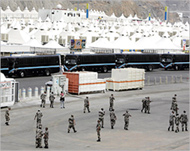Saudis plan for accident-free Haj
Saudi authorities will be facing a tough challenge as they cope with fitting nearly two million Haj pilgrims in a two-square-km space.

Spurred by deadly incidents that have marred the annual Haj over the years, Saudi Arabia has been introducing measures to make the pilgrimage safer, notably by helping the smooth movement of pilgrims between holy sites.
The Custodian of the Two Holy Mosques Institute for Haj Research, which was founded in 1975, regularly submits proposals to the government on ways of avoiding the repetition of stampedes and other accidents.
“The Haj is a mega event, comparable to the World Cup or the Olympics,” the institute’s head, Usama al-Bar, said as the Haj started on Tuesday.
“Fitting more than two million people in such a small space is no easy task.”
Al-Bar cautioned that it was not possible to totally avoid rushes that sometimes degenerate into deadly stampedes. But “authorities are doing their best”, he said.
Pillars replaced
 |
|
Saudi police patrol the site where |
A total of $28 million were spent on modernising the jamarat, as the three pillars symbolising the devil that are stoned by pilgrims are called, since 251 faithful were trampled or suffocated during a crush while performing that ritual last year.
The pillars in Mina, near Mecca, have been replaced by 25m high walls that stones can hit more easily, and the concrete enclosure of the site has been coated with rubber to dampen the shocks.
Cameras and sensors have been installed to enable security forces to intervene rapidly in case of a rush or reduce the flow of pilgrims if the place becomes dangerously crowded.
Al-Bar said no less than 22,000 buses would be used to ferry pilgrims on Tuesday from Mecca to Mina and on to Mount Arafat on Wednesday for the climax of the Haj.
“Mina covers an area of eight square km, half of which are a mountainous zone. Two square km are taken up by roads and infrastructure, leaving just two square km to accommodate the pilgrims,” al-Bar said.
“That’s twice the population density of the Gaza Strip, which is the highest in the world.”
Cars banned
|
“The Haj is a mega event, comparable to Usama al-Bar, head of the Custodian of the Two Holy Mosques Institute for Haj Research |
It was on the recommendation of al-Bar’s institute that private cars were barred from the holy sites in 1983 in an effort to reduce traffic jams.
Also on the institute’s advice, pilgrims have since 1995 been allowed to move along the stoning site in one direction only to decrease the risk of stampedes.
Fifty-four tunnels have been built over three decades in the Mecca region to ease traffic jams during the Haj season, al-Bar said.
However, the institute’s proposals are sometimes resisted by a conservative religious establishment.
“It took a lot to be able to change the shape of the pillars and basins,” al-Bar said.